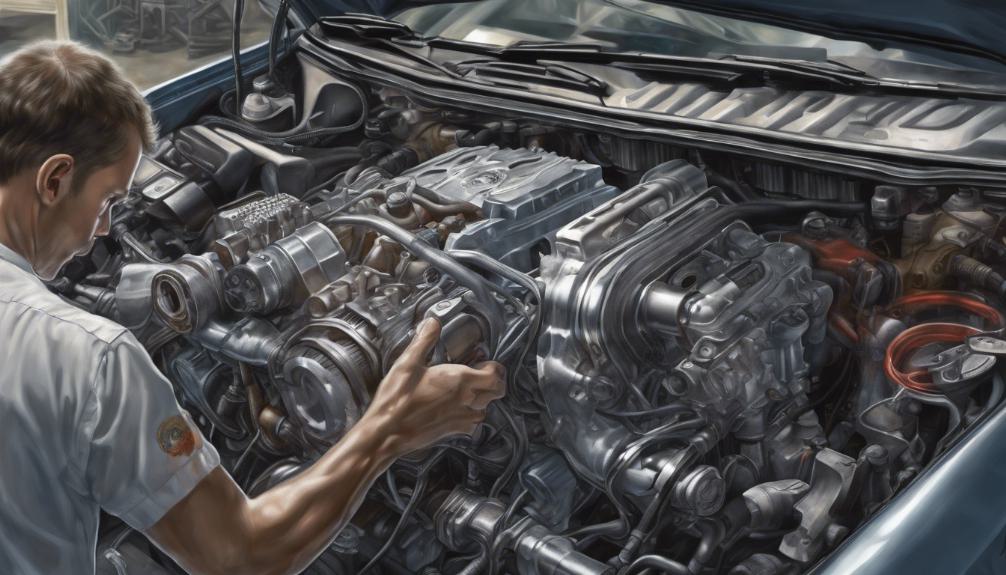When facing the P000D code related to Exhaust B Camshaft Position Slow Response in Bank 2, start by acknowledging the importance of this issue for engine health.
This code indicating a slow response can affect performance, so taking action promptly is key. Symptoms like the check engine light and engine noise hint at camshaft problems.
Common culprits include faulty oil control solenoids or cam sensors. To diagnose, you may need to test components like cam sensors and solenoid circuits. Seeking expert advice can help identify and fix the root cause efficiently.
Exploring further will reveal detailed steps to resolve this concern.
What You Need to Know
- Importance of P000D for diagnosing B camshaft position in Bank 2.
- Effects: check engine light, emissions increase, poor engine performance.
- Causes: oil control solenoid, camshaft sensor, sprocket issues.
- Diagnostic steps: swap sensors, test circuits, check wiring.
- Professional assistance: consult technicians, inspect components, seek service center help.
Code Overview and Significance

Understanding the importance of the P000D trouble code and its implications is vital for diagnosing potential issues with the exhaust B camshaft position in Bank 2.
The P000D: B camshaft code specifically points to a Position Slow Response in the camshaft position, particularly in Bank 2 of the engine.
This trouble code signifies that the camshaft isn’t adjusting as quickly or accurately as required, impacting the engine’s performance.
When this code triggers, it often leads to the illumination of the check engine light on your dashboard.
It is essential to address the P000D code promptly as it can impact various aspects of your vehicle’s operation.
Failure to resolve this issue can result in poor engine performance, noticeable engine noise, and increased emissions.
By understanding the significance of this code and its relation to the camshaft position, you can take the necessary steps to diagnose and rectify the underlying problem before it escalates into more severe issues with your vehicle’s performance.
Symptoms and Effects on Performance
To evaluate the impact of the P000D code on your vehicle’s performance, recognizing the symptoms and effects is essential. Here are some key indicators to look out for:
- Illuminated check engine light: This warning sign alerts you to a potential issue with the camshaft position slow response in bank 2.
- Increased emissions: The P000D code can lead to higher emissions due to improper camshaft timing.
- Poor engine performance: You may experience a decrease in engine power and overall performance.
- Engine noise: Unusual noises such as ticking or knocking may occur as a result of the camshaft position slow response.
- Faulty control solenoid or oil control valves: Issues with these components can contribute to the P000D code and its associated symptoms.
Keep an eye out for these signs to address the P000D code promptly and maintain your vehicle’s performance.
Potential Causes of the P000D Code

When diagnosing the P000D code, a malfunctioning oil control solenoid is a common culprit worth investigating.
The oil control solenoid plays an important role in regulating oil flow and pressure to the camshaft position, affecting the overall performance of your vehicle.
Issues with the oil pressure can trigger the P000D fault code, signaling a potential malfunction in this component.
Then, a faulty camshaft position sensor or problems with the cam sprocket assembly can also lead to the appearance of the P000D code on your diagnostics.
It’s essential to take into account these factors when troubleshooting the source of the issue.
Seeking assistance from an auto repair shop with specialized diagnostic tools can help pinpoint the exact cause of the problem.
The control module (PCM) in your vehicle relies on accurate readings from various sensors to ensure excellent performance, making it crucial to address any issues related to the camshaft position promptly.
Diagnostic Steps and Troubleshooting Methods
Inspect the camshaft position sensor, oil control solenoid, and wiring for any potential issues as part of the diagnostic steps and troubleshooting methods for addressing the P000D code.
To effectively diagnose and troubleshoot this issue, follow these steps:
- Swap Components: Swap cam sensors and solenoids to determine if any of these components are faulty.
- Test Circuits: Testing the camshaft position sensor circuit and oil control solenoid circuit is essential for accurate diagnosis.
- Consult Diagnostic Flow Chart: Refer to the manufacturer’s diagnostic flow chart for specific guidance on troubleshooting the P000D code.
- Check Wiring: Verify all wiring related to the camshaft position sensor and oil control solenoid is intact and properly connected.
- Verify Connections: Double-check all connections to the camshaft position sensor and oil control solenoid for any loose or damaged connections.
Professional Assistance and Solutions

For professional insight into resolving the P000D code, consider consulting experienced technicians familiar with diagnosing complex engine issues.
These professionals have the expertise to perform technical tests that can accurately pinpoint factors contributing to the Exhaust B Camshaft Position Slow Response, Bank 2 error.
During the diagnostic process, they’ll carefully inspect essential components such as the camshaft position, oil control solenoid, sensor circuits, and timing chain.
By evaluating these elements thoroughly, a mechanic can provide you with valuable insight into the specific issues causing the P000D code in your vehicle.
Professional service centers are equipped with the necessary tools and knowledge to diagnose and repair the P000D code effectively.
Their experience in handling intricate engine problems makes them well-suited to address the challenges associated with this error code.
Seeking assistance from these service centers can help you identify and resolve the root cause of the problem, ensuring that your vehicle operates efficiently.
As an Amazon Associate we earn from qualifying purchases.










